Swashbuckler Swordplay Action
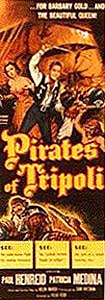 In the history of cinema in the western world, swordplay & other martial arts have been, to a large degree, unrealistic buffoonery designed to dazzle the naive or even win a laugh. But the realism seen in the samurai films of Kurosawa & many others has always been rare in swashbuckler cinema of America & England.
In the history of cinema in the western world, swordplay & other martial arts have been, to a large degree, unrealistic buffoonery designed to dazzle the naive or even win a laugh. But the realism seen in the samurai films of Kurosawa & many others has always been rare in swashbuckler cinema of America & England.
From the silent era to the post-war period films with realistic swordplay just weren't to be found. Douglas Fairbanks, Sr., in the two-strip technicolar silent film classic The Black Pirate (1926) fends off a dozen opponents with sweeping parries. His stance is fine, thanks to the coaching of fencing master Fred Cavens. But ultimately it's played for charm, not for realism.
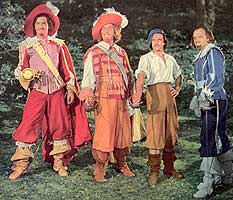 In the 1948 color version of The Three Musketeers there are protracted displays of action. But faencing instructor Jean Hereman could not make Gene Kelly look like more than an awfully fine dancer in this excesively lighthearted foray. In the 1948 color version of The Three Musketeers there are protracted displays of action. But faencing instructor Jean Hereman could not make Gene Kelly look like more than an awfully fine dancer in this excesively lighthearted foray.
Such jolly spectacles are fun but don't quite rate on the basis of believable use of arms. The logical outcome of these sorts of sweety-pie adventures was, perhaps, The Court Jester (1956).
That inverterate clown Danny Kaye, in the title role, is pitted against authentic fencing master Basil Rathbone in a willfully silly duel, choreographed by fencing master Ralph Faulkner only to keep anyone from getting hurt.
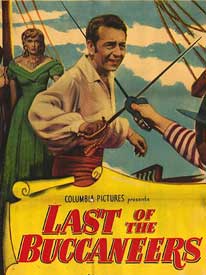 The best swashbucklers did, however, incorporate some genuine fencing techniques. Basil Rathbone, Douglas Fairbanks, Jr., & Cornel Wilde were among the swashbuckling stars who were actual fencers. Others, like Doug Fairbanks, Sr., & his cinematic heir Errol Flynn, had enough athletic flair & ability to occasionally give a convincing fight. Some of the world's best fencers were coaching them & choreographing their duels. The best swashbucklers did, however, incorporate some genuine fencing techniques. Basil Rathbone, Douglas Fairbanks, Jr., & Cornel Wilde were among the swashbuckling stars who were actual fencers. Others, like Doug Fairbanks, Sr., & his cinematic heir Errol Flynn, had enough athletic flair & ability to occasionally give a convincing fight. Some of the world's best fencers were coaching them & choreographing their duels.
Binnie Barns studied months in advance in order to bring a higher than usual degree of believability to her swordswoman role in The Spanish Main (1945). Paul Heinreid had fencing experience as well, enlevining not only The Spanish Main but also helping to redeem Last of the Buccaneers (1950) & The Pirates of Tripoli (1955).
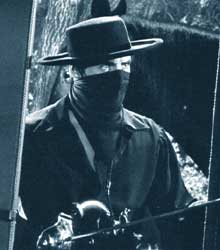 In the cases of actors who were total wash-outs when it came to swordsmanship (Tyrone Power chief among them, & Errol Flynn in his darker hours), the stand-ins were often those same champion fencers who were coaching & choreographing. In the cases of actors who were total wash-outs when it came to swordsmanship (Tyrone Power chief among them, & Errol Flynn in his darker hours), the stand-ins were often those same champion fencers who were coaching & choreographing.
It boils down to the simple fact that occasionally fencing arts have been portrayed with precision & grace in the classic swashbucklers, but it's not to be expected.
Tyrone Power in the visually stunning The Mark of Zorro (1940) birthed so many Zorro imitations that the merits of Rouben Mamoulian's film are sometimes forgotten.
Scene for scene, there is beauty in the black & white photography which gives Spanish California & its sword-bedecked caballeros overwhelming mythic power.
The colorized version should be avoided not only because it isn't the film Mamoulian intended, but also because its edges are badly cropped.
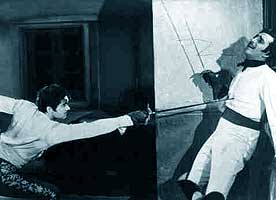 The choreography includes excellent swordplay with foils & sabres, & there is even a peasant uprising replete with swinging scythes, swords, & wooden clubs. To pull it off required a lot of effort on the part of the stunt doubles, as Tyrone really couldn't fence. The choreography includes excellent swordplay with foils & sabres, & there is even a peasant uprising replete with swinging scythes, swords, & wooden clubs. To pull it off required a lot of effort on the part of the stunt doubles, as Tyrone really couldn't fence.
Tyrone's off-screen bisexuality translated nicely into the on-screen "fop by day, hero by night." This character archetime was a common one from swashbuckling novels, & one of the great interpretations was Leslie Howard's take on The Scarlet Pimpernel (1935), a first-rate film inspired by Baroness Orczy's novel of the same name.
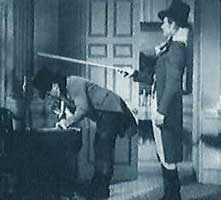 The effeminacy of such characters was always intended to disguise their essentially heroic nature, to mislead people who could not believe a prissy fop who flirts with boys might well be a great swordsman & lover of women. The effeminacy of such characters was always intended to disguise their essentially heroic nature, to mislead people who could not believe a prissy fop who flirts with boys might well be a great swordsman & lover of women.
In the case of Tyrone Power's Mark of Zorro, however, a critic for The New York Times could not resist noting with derogatory wit that Ty's alternatingly swishy & swashbuckling figure "rather overdoes the swishing, & his swash is more beautiful than bold."
It was a prejudiced & largely unfair slam from someone jealous that Tyrone looked so dreamy in raccoon mask & tights.
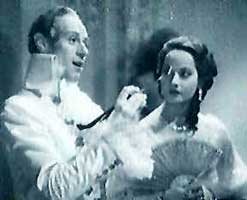 As an interesting aside, director Mamoulian also used the androgynous beauty of Greta Garbo to convey the lesbianism of Queen Christina (1933). As an interesting aside, director Mamoulian also used the androgynous beauty of Greta Garbo to convey the lesbianism of Queen Christina (1933).
And it would have been much more obvious but that Mamoulian's initial vision was assaulted by drastic censorship to delete overt references to what was popular knowledge at the time, thanks to the bestselling biography of Christina's actual life.
Even censored, the result was a lovely moody film wotj the image but not the pacing & action of a swashbuckler.
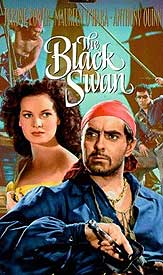 Tyrone was extensively doubled in The Mark of Zorro by Albert Cavens, son of fencing master Fred Cavens. In subsequent films, Power's lack of exertise made for lousy duels, as in the otherwise entertaining The Black Swan (1942).
Tyrone was extensively doubled in The Mark of Zorro by Albert Cavens, son of fencing master Fred Cavens. In subsequent films, Power's lack of exertise made for lousy duels, as in the otherwise entertaining The Black Swan (1942).
In The Black Swan, Ty's awkward duel-to-the-finish with George Sanders was excessively speeded up, creating the illusion of tightly wound toys. Never did a film cry out more loudly for Fred Cavens' aid!
In Mark of Zorrow, however, the classy direction of Mamoulian & the grand help of father & son Cavenses fooled more than a few viewers into believing Tyrone could fight.
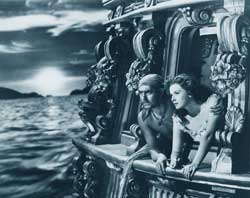 And Power's co-star in The Mark of Zorro, by contrast to Ty, had studied fencing from the age of eighteen. Indeed, Basil Rathbone might have been a world-class champion had been interested in tournaments. And Power's co-star in The Mark of Zorro, by contrast to Ty, had studied fencing from the age of eighteen. Indeed, Basil Rathbone might have been a world-class champion had been interested in tournaments.
There was never any need for clever editing or shots of the back of the head where his rawboned, knife-sharp visage & physique were concerned. He fought his own duels & the only thing unrealistic about them was that in film after film, he failed to kill the hero.
Because Rathbone required no double, he is invariably a film's most exciting presence. It is a pity no director saw his potential as a heroic lead rather than a villain. The genre never grew up enough to develop genuine anti-heroes at which Rathbone would have excelled.
Instead of becoming a mature cinema with psychological depth & unpretty heroes (the way Roy Rogers & Gene Autry westerns gave way to grittier takes from Peckpah & Sturgis), the genre degerated into self-parody.
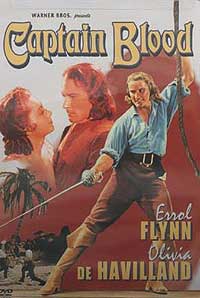 The parodic elements were there from the silent era onward, in Doug, Sr.'s athletic antics & easy grin. But in the best films, it was easy to believe danger was real. The parodic elements were there from the silent era onward, in Doug, Sr.'s athletic antics & easy grin. But in the best films, it was easy to believe danger was real.
Captain Blood (1935) was another remake (like The Mark of Zorro initially of a silent classic), launching Errol Flynn to super-stardom. Fred Cavens once again choreographed good swordplay.
Flynn, a good boxer, could pull off Gentleman Jim (1942), the boxing sequence to Perfect Gentleman (1937), or barroom brawls in such films as Dodge City (1939).
But as a duellist, he was dependent on Cavens to make him look good, & on his own athletic bravado, plus occasional doubles who would become more common as his career progressed.
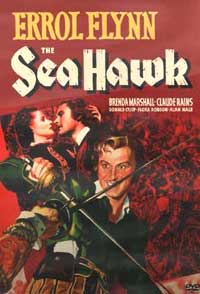 Flynn probably could've handled more than he did, but was drinking on the set even in 1935, which caused many retakes & added a certain danger that was circumvented by pitting a double against Rathbone. Flynn probably could've handled more than he did, but was drinking on the set even in 1935, which caused many retakes & added a certain danger that was circumvented by pitting a double against Rathbone.
Rathbone was once quoted as saying he was tempted to run Flynn through, due to his unprofessional antics. No one knew then of his secret health problems.
Despite problems in production, the only thing that makes Cavens' choreography in Captain Blood weak is the technical habit in those days of speeding up the action, a hold-over from silent film technique, & still seen in some kung fu films today. The technique is less jolting in The Sea Hawk (1940), with Cavens completely in control of the choreography.
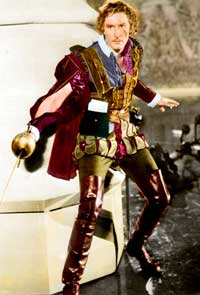 "Completely" in control is no overstatement. Henry Daniell turned in a super performance as chief villain, only slightly less sharp & sinister than Rathbone, but he lacked Rathbone's fencing skills. So Henry as well as Flynn had to be doubled by experts. The duels, then, were essentially the work of Cavens' throughly skillful students. "Completely" in control is no overstatement. Henry Daniell turned in a super performance as chief villain, only slightly less sharp & sinister than Rathbone, but he lacked Rathbone's fencing skills. So Henry as well as Flynn had to be doubled by experts. The duels, then, were essentially the work of Cavens' throughly skillful students.
For the viewer wanting to see the star doing his own stuff, this is clearly cheating. For the viewer simply interested in authentic duels, the use of doubles in the case of The Sea Hawk was surely to the best.
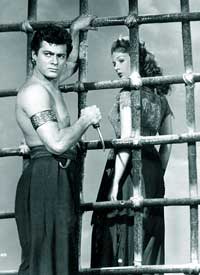 One can look at the great body of swashbucklers with one of two attitudes: that it's a stunning & powerful film literature; or that it's appalling how few good swordfights surface in hundreds of films.
One can look at the great body of swashbucklers with one of two attitudes: that it's a stunning & powerful film literature; or that it's appalling how few good swordfights surface in hundreds of films.
It is indeed a pity how few films contain startling swordplay. Basil Rathbone's duels in pre-war classics were charged with authority & realism, something that would become rare in post-war films.
Where for instance is the authority or realism when Tony Curtis plays with his sword or knocks opponents off horses in The Prince Who was a Thief (1951)? It's a film that has gone down in history not as thrilling adventure, but for that thick Brooklyn accent bragging about the "castle of my fodder."
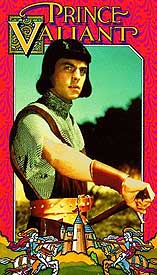 The closest thing to a classic swashbuckler with serious intentions to come out of the 1950s was, absurdly, Prince Valiant (1954), as opposed to far better swashbucklers of the '50s which were played mostly for their their humor. The closest thing to a classic swashbuckler with serious intentions to come out of the 1950s was, absurdly, Prince Valiant (1954), as opposed to far better swashbucklers of the '50s which were played mostly for their their humor.
Valiant with its broadsword action though exemplary for the '50s is a stupid film compared to best work from 1935-49.
The sillness of such stories & the miscasting of Richard Wagner or Tony Curtis (& Rock Hudson or Paul Newman in films they'd probably prefer went unmentioned) seemed to prove that swashbucklers were really only good for slapstick like The Crimson Pirate (1952). Absurdness appeared to be inherent to the genre.
The Crimson Pirate includes some fun acrobatics reminiscent of the silent films. Burt Lancaster personally performed the magnificent stunts & repeated them for doubters when on tour promoting this & his earlier The Flame & the Arrow (1950).
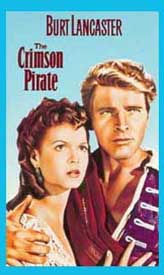 But his films have an excessive circus atmosphere, cashing in on Burt's background as a circus acrobat. In the swordplay department they fall well below charade. Batting a few shortswords at each other is the extent of it. But his films have an excessive circus atmosphere, cashing in on Burt's background as a circus acrobat. In the swordplay department they fall well below charade. Batting a few shortswords at each other is the extent of it.
There have been moments since the 1970s when it looked like serious swordplay films might make a come-back, but they surfaced almost as flukes.
The Duellists (1979) is the rare case of an artistic cinematic achievement with grueling realism when sword meets sword. Richard Lester's touching Robin & Marian (1976) includes sensible broadsword technique, redressing the errors of The Adventures of Robin Hood (1948) wherein broadswords were paried & thrust like epees.
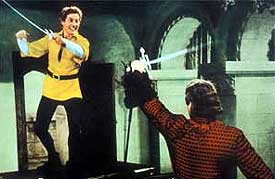 By & large, however, we've seen only film descendants of The Crimson Pirate & The Court Jester while the genre fails utterly to take itself serioiusly. By & large, however, we've seen only film descendants of The Crimson Pirate & The Court Jester while the genre fails utterly to take itself serioiusly.
Comic swashbucklers like Start the Revolution Without Me (1970) spoofing The Corsican Brothers & the umpteenth version of The Pirates of Penzance (1983) with Kevin Kline dangling prettily by his heals. These are worthwhile romps, but as swashbuckling adventure they fall short.
One misses the intensity of a Rathbone when watching a dewy Richard Chamberlain; or a tough, real story like The Corsican Brothers (1942) or Prisoner of Zenda (1937 version, of course) when seeing, instead, the gross campiness of Zorro the Gay Blade (1981) with the subtltety of Mamoulian's classic's allusion to homosexuality transformed into the tackiest jokes.
Then in the new millenium we get the Pirates of the Caribbean franchise played for nonstop laughs & reliant of special FX.
It's sad to think the last serious minded pirate film may have been Robert Shaw in Swashbuckler (1976), & even that has slapstick interludes, with just about everthing since either a children's film or all-out slapstick comedy.
copyright © by Paghat the Ratgirl
|


 In the 1948 color version of The Three Musketeers there are protracted displays of action. But faencing instructor Jean Hereman could not make Gene Kelly look like more than an awfully fine dancer in this excesively lighthearted foray.
In the 1948 color version of The Three Musketeers there are protracted displays of action. But faencing instructor Jean Hereman could not make Gene Kelly look like more than an awfully fine dancer in this excesively lighthearted foray. The best swashbucklers did, however, incorporate some genuine fencing techniques. Basil Rathbone, Douglas Fairbanks, Jr., & Cornel Wilde were among the swashbuckling stars who were actual fencers. Others, like Doug Fairbanks, Sr., & his cinematic heir Errol Flynn, had enough athletic flair & ability to occasionally give a convincing fight. Some of the world's best fencers were coaching them & choreographing their duels.
The best swashbucklers did, however, incorporate some genuine fencing techniques. Basil Rathbone, Douglas Fairbanks, Jr., & Cornel Wilde were among the swashbuckling stars who were actual fencers. Others, like Doug Fairbanks, Sr., & his cinematic heir Errol Flynn, had enough athletic flair & ability to occasionally give a convincing fight. Some of the world's best fencers were coaching them & choreographing their duels. In the cases of actors who were total wash-outs when it came to swordsmanship (Tyrone Power chief among them, & Errol Flynn in his darker hours), the stand-ins were often those same champion fencers who were coaching & choreographing.
In the cases of actors who were total wash-outs when it came to swordsmanship (Tyrone Power chief among them, & Errol Flynn in his darker hours), the stand-ins were often those same champion fencers who were coaching & choreographing. The choreography includes excellent swordplay with foils & sabres, & there is even a peasant uprising replete with swinging scythes, swords, & wooden clubs. To pull it off required a lot of effort on the part of the stunt doubles, as Tyrone really couldn't fence.
The choreography includes excellent swordplay with foils & sabres, & there is even a peasant uprising replete with swinging scythes, swords, & wooden clubs. To pull it off required a lot of effort on the part of the stunt doubles, as Tyrone really couldn't fence. The effeminacy of such characters was always intended to disguise their essentially heroic nature, to mislead people who could not believe a prissy fop who flirts with boys might well be a great swordsman & lover of women.
The effeminacy of such characters was always intended to disguise their essentially heroic nature, to mislead people who could not believe a prissy fop who flirts with boys might well be a great swordsman & lover of women. As an interesting aside, director Mamoulian also used the androgynous beauty of Greta Garbo to convey the lesbianism of Queen Christina (1933).
As an interesting aside, director Mamoulian also used the androgynous beauty of Greta Garbo to convey the lesbianism of Queen Christina (1933).
 And Power's co-star in The Mark of Zorro, by contrast to Ty, had studied fencing from the age of eighteen. Indeed, Basil Rathbone might have been a world-class champion had been interested in tournaments.
And Power's co-star in The Mark of Zorro, by contrast to Ty, had studied fencing from the age of eighteen. Indeed, Basil Rathbone might have been a world-class champion had been interested in tournaments. The parodic elements were there from the silent era onward, in Doug, Sr.'s athletic antics & easy grin. But in the best films, it was easy to believe danger was real.
The parodic elements were there from the silent era onward, in Doug, Sr.'s athletic antics & easy grin. But in the best films, it was easy to believe danger was real. Flynn probably could've handled more than he did, but was drinking on the set even in 1935, which caused many retakes & added a certain danger that was circumvented by pitting a double against Rathbone.
Flynn probably could've handled more than he did, but was drinking on the set even in 1935, which caused many retakes & added a certain danger that was circumvented by pitting a double against Rathbone. "Completely" in control is no overstatement. Henry Daniell turned in a super performance as chief villain, only slightly less sharp & sinister than Rathbone, but he lacked Rathbone's fencing skills. So Henry as well as Flynn had to be doubled by experts. The duels, then, were essentially the work of Cavens' throughly skillful students.
"Completely" in control is no overstatement. Henry Daniell turned in a super performance as chief villain, only slightly less sharp & sinister than Rathbone, but he lacked Rathbone's fencing skills. So Henry as well as Flynn had to be doubled by experts. The duels, then, were essentially the work of Cavens' throughly skillful students.
 The closest thing to a classic swashbuckler with serious intentions to come out of the 1950s was, absurdly, Prince Valiant (1954), as opposed to far better swashbucklers of the '50s which were played mostly for their their humor.
The closest thing to a classic swashbuckler with serious intentions to come out of the 1950s was, absurdly, Prince Valiant (1954), as opposed to far better swashbucklers of the '50s which were played mostly for their their humor. But his films have an excessive circus atmosphere, cashing in on Burt's background as a circus acrobat. In the swordplay department they fall well below charade. Batting a few shortswords at each other is the extent of it.
But his films have an excessive circus atmosphere, cashing in on Burt's background as a circus acrobat. In the swordplay department they fall well below charade. Batting a few shortswords at each other is the extent of it. By & large, however, we've seen only film descendants of The Crimson Pirate & The Court Jester while the genre fails utterly to take itself serioiusly.
By & large, however, we've seen only film descendants of The Crimson Pirate & The Court Jester while the genre fails utterly to take itself serioiusly.